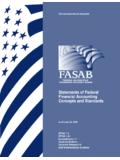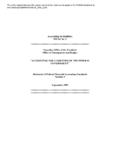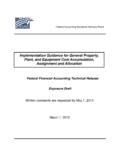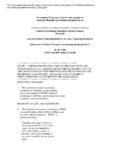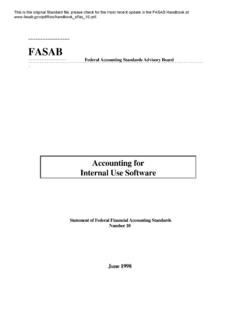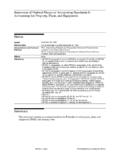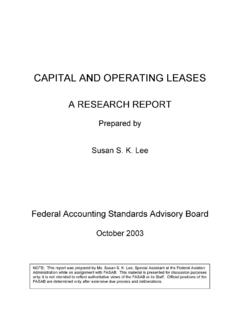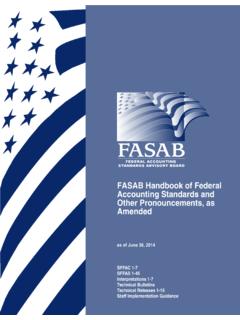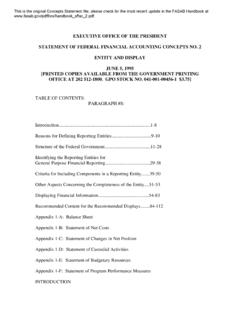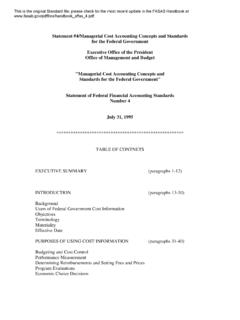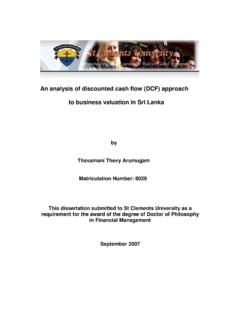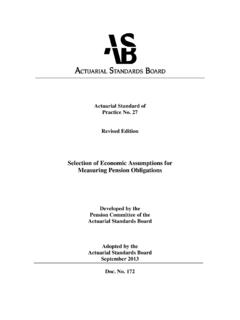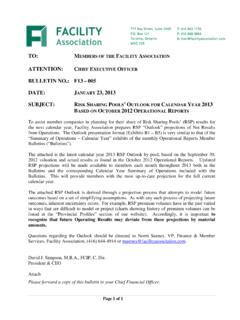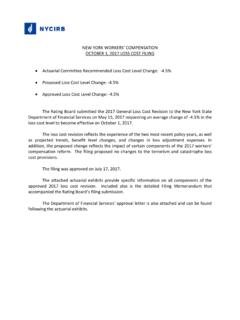Transcription of Pensions, Other Retirement Benefits, and Other ...
1 Pensions, Other Retirement benefits , and Other postemployment benefits : Reporting the Gains and Losses from Changes in Assumptions and Selecting Discount Rates and Valuation Dates Statement of Federal Financial Accounting Standards 33 October 14, 2008 Federal Accounting Standards Advisory Board This is the original Standard file; please check for the most recent update in the FASAB Handbook at THE FEDERAL ACCOUNTING STANDARDS ADVISORY BOARD The Federal Accounting Standards Advisory Board (FASAB or "the Board") was established by the Secretary of the Treasury, the Director of the Office of Management and Budget (OMB), and the Comptroller General in October 1990. It is responsible for promulgating accounting standards for the United States Government. These standards are recognized as generally accepted accounting principles (GAAP) for the federal government. An accounting standard is typically formulated initially as a proposal after considering the financial and budgetary information needs of citizens (including the news media, state and local legislators, analysts from private firms, academe, and elsewhere), Congress, federal executives, federal program managers, and Other users of federal financial information.
2 The proposed standard is published in an Exposure Draft for public comment. In some cases, a discussion memorandum, invitation to comment, or preliminary views document may be published before an exposure draft is published on a specific topic. A public hearing is sometimes held to receive oral comments in addition to written comments. The Board considers comments and decides whether to adopt the proposed standard, with or without modification. After review by the three officials who sponsor FASAB, the Board publishes adopted standards in a Statement of Federal Financial Accounting Standards. The Board follows a similar process for Interpretations and also for Statements of Federal Financial Accounting Concepts, which guide the Board in developing accounting standards and formulating the framework for federal accounting and reporting. Additional background information is available from the FASAB or its website: "Memorandum of Understanding among the General Accounting Office, the Department of the Treasury, and the Office of Management and Budget, on Federal Government Accounting Standards and a Federal Accounting Standards Advisory Board" "Mission Statement: Federal Accounting Standards Advisory Board" Exposure drafts, Statements of Federal Accounting Standards and Concepts, Interpretations, FASAB newsletters, and Other items of interest are posted on FASAB s website, at Federal Accounting Standards Advisory Board 441 G Street NW, Suite 6814 Mailstop 6K17V Washington, DC 20548 Telephone (202) 512-7350 Fax (202) 512-7366 This is a work of the U.
3 S. government and is not subject to copyright protection in the United States. It may be reproduced and distributed in its entirety without further permission from FASAB. However, because this work may contain copyrighted images or Other material, permission from the copyright holder may be necessary if you wish to reproduce this material separately. This is the original Standard file; please check for the most recent update in the FASAB Handbook at Federal Accounting Standards Advisory Board Pensions, Other Retirement benefits , and Other postemployment benefits : Reporting Gains and Losses from Changes in Assumptions, and Selecting Discount Rates and Valuations Dates October 14, 2008 Summary During its consideration of long-term obligations, the Board discussed the need to highlight gains and losses from changes in assumptions in federal financial reports. Some of the most significant changes in amounts on the statement of net cost for the consolidated Financial Report of the United States Government (CFR) and for certain component entities can result from gains and losses from changes in assumptions.
4 This Statement addresses that need. This Statement applies to federal entities that report liabilities and expenses for federal employee pensions, Other Retirement benefits (ORB), and Other postemployment benefits (OPEB) in general purpose financial reports prepared pursuant to Federal Accounting Standard Advisory Board standards. This Statement requires gains and losses from changes in long-term assumptions used to estimate federal employee pension , ORB, and OPEB liabilities to be displayed on the statement of net cost separately from Other costs. Separate display will provide more transparent information regarding the underlying costs associated with these liabilities. This Statement also requires disclosure of the components of the expense associated with federal employee pension , ORB, and OPEB liabilities in notes to the financial statements. Such disclosure will provide useful information for analysis.
5 The information will be comparable across agencies and between postemployment and Retirement programs. This Statement also provides a standard for selecting the discount rate assumption for present value estimates of federal employee pension , ORB, and OPEB liabilities. There is currently uncertainty in practice in this regard. This Statement also provides a standard for selecting the valuation date for estimates of federal employee pension , ORB, and OPEB liabilities, which will establish a consistent method for such measurements. This is the original Standard file; please check for the most recent update in the FASAB Handbook at of Contents Federal Accounting Standards Advisory Board Pensions, Other Retirement benefits , and Other postemployment benefits : Reporting Gains and Losses from Changes in Assumptions, and Selecting Discount Rates and Valuations Dates October 14, 2008 Table of Contents Introduction .. 3 3 3 Proposed Accounting 6 Display.
6 7 Selecting Discount Selecting Valuation Date ..9 Effect on Prior Appendix A: Basis for Display ..14 Selecting Discount Selecting Valuation Date ..28 Appendix B: Pro Forma Statement of Net Cost Displaying Separate Line Item for Gains and Losses Due to Changes in Assumptions ..32 Appendix C: Pro Forma Note Disclosure of OPEB Liabilities and Appendix D: Note 11 from FY 2006 Financial Report of the United States ..34 Appendix E: Appendix F: List of Abbreviations ..39 This is the original Standard file; please check for the most recent update in the FASAB Handbook at Introduction 3 Federal Accounting Standards Advisory Board Pensions, Other Retirement benefits , and Other postemployment benefits : Reporting Gains and Losses from Changes in Assumptions, and Selecting Discount Rates and Valuations Dates October 14, 2008 Introduction Purpose 1. This statement requires the following: A. Gains and losses from changes in long-term assumptions1 used to estimate federal employee pension , Other Retirement benefit (ORB), and Other postemployment benefit (OPEB) liabilities should be displayed on the statement of net cost separately from Other costs.
7 This display will provide more transparent information regarding the underlying costs associated with certain liabilities. B. Components of the expense associated with federal employee pension , ORB, and OPEB liabilities should be disclosed in notes to the financial statements. Such disclosure will provide information useful for analysis. The information will be comparable across agencies and between postemployment and Retirement programs. 2. This statement also provides standards for selecting: A. The discount rate assumption for pension , ORB, and OPEB liabilities. There is currently uncertainty in practice regarding the selection of discount rates in some situations. B. The valuation date for measuring pension , ORB, and OPEB liabilities, which will establish a consistent method for such measurements. Background Reporting Gains and Losses from Changes in Assumptions 3.
8 During its discussions of long-term obligations the Board addressed the need to highlight certain gains and losses from changes in assumptions in federal financial reports. Some of the most significant changes in amounts on the statement of net cost for the consolidated Financial Report of the United States Government (CFR)2 and for certain component entities can result from gains and losses from changes in assumptions. The Board is now requiring that such gains and losses be reported as a discrete line item on the statement of net cost. Selecting the Discount Rates 4. SFFAS 5 provides standards for several types of liabilities, some of which require present value valuations. Federal accounting standards requiring present valuations 1 Terms in the Glossary are shown in boldface the first time they appear in this document.
9 2 See Appendix D containing Note 11, Federal Employee and Veterans benefits Payable, from the FY 2006 CFR. This is the original Standard file; please check for the most recent update in the FASAB Handbook at Introduction 4 Federal Accounting Standards Advisory Board Pensions, Other Retirement benefits , and Other postemployment benefits : Reporting Gains and Losses from Changes in Assumptions, and Selecting Discount Rates and Valuations Dates October 14, 2008 usually specify U. S. Treasury borrowing rates as the discount rates, although the terminology used differs. 5. With respect to the selection of assumptions for pension , ORB, and OPEB liabilities, including the discount rate assumption, SFFAS 5 emphasizes expected long-term future trends rather than recent past experience. For the discount rate, SFFAS 5 required either the entity s long-term investment yield on assets, if the benefit plan is being funded, or Other long-term assumptions such as Treasury borrowing rates for securities of similar maturity to the period over which the payments are to be 6.
10 Some entities interpreted the SFFAS 5 standard with respect to Other postemployment benefits (OPEB) to require the use of single-day Treasury rates for the discount rates. Single-day rates render liability projections susceptible to more volatility than, for example, rates based on long-term expectations or historical experience. 7. Liabilities for postemployment and Retirement benefits can be very large. The combination of the magnitude of these liabilities and volatility of the projections has resulted in large variations in annual cost from year to year that reduces the usefulness of reported operating results. 8. FASAB standards that require the use of Treasury borrowing rates for discounting do not specify a precise method for selecting such rates. There were a number of options for the discount rate. However, the discount rate generally required in FASAB standards is the rate on marketable Treasury securities of similar maturity to the cash flows of the obligation in question.
